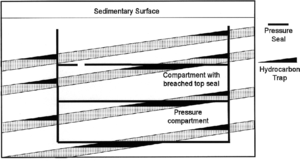Pressure compartments
| Exploring for Oil and Gas Traps | |

| |
| Series | Treatise in Petroleum Geology |
|---|---|
| Part | Critical elements of the petroleum system |
| Chapter | Formation fluid pressure and its application |
| Author | Edward A. Beaumont, Forrest Fiedler |
| Link | Web page |
| Store | AAPG Store |
Pressure compartments are found in basins worldwide. A pressure compartment is a volume of rock, all sides of which are sealed such that the fluid within the compartment is isolated from the surrounding normal pressure regime. Pressure compartments affect the movement of fluids that control the migration and accumulation of petroleum and the diagenesis of reservoirs and seals.
Impact on petroleum geology
Pressure compartments have a significant impact on the distribution of oil and gas within a basin. Leonard[1] lists ways pressure compartments affect elements of petroleum geology:
- Porosity loss due to compaction is less in overpressured and more in underpressured rocks than in normally pressured rocks.
- Lack of fluid movement in pressure compartments reduces the supply of free ions associated with cementation and secondary porosity formation.
- Temperature increase associated with overpressured compartments decreases the depth of burial for ]]Petroleum generation||hydrocarbon generation]].
- Fracturing of the top seal could be a key to primary and secondary hydrocarbon migration and location of traps.
- Mapping well-to-well pressure variation could identify sealing faults.
Porosity preservation

Overpressured compartments impede porosity loss due to compaction. For example, chalks worldwide begin with porosities greater than 50%. During burial in normally pressured sections, chalk porosities decrease to less than 10% at depths of depth::1500 m or more. In overpressured compartments of the North Sea, chalks have porosities of 40% or more at depths of depth::2500 m and 25% or more at depths of depth::3000 m or more.[1] These porosities are those that would be expected at 700-1200 m in normally pressured rock sections.
Figure 1 is a porosity-depth plot for chalks worldwide.
Diagenesis in compartments
Pore fluid movement within pressure compartments is quite limited because compartments are sealed from surrounding beds. Sediments in a pressure compartment may escape both reservoir-destroying cementation and reservoir-enhancing grain dissolution.
Effect on hydrocarbon maturation

The temperature gradient usually increases below the top seal of pressure compartments because the top seal provides a thermal blanket for underlying sediments. This increase in temperature increases the rate of hydrocarbon maturation within the compartment. Figure 2 shows temperature gradient increase below the top seal.
Concentration of traps
In many regional pressure compartments, hydrocarbon generation creates pressures great enough to fracture the top seal. Top-seal fracturing episodically releases pressure and fluids, including oil and gas, from the pressure compartment. Oil and gas tend to be trapped in the first reservoir-quality rock over leak points.[1] Leak points form where the top seal is shallowest because fracture pressure is lowest in the top seal at that point. Leak points also can occur where faults are reactivated during tectonic events.[2]
Compartment-associated traps

The diagram (Figure 3) is a schematic cross section of traps associated with pressure compartments.[4]
See also
- Regional pressure compartments
- Subregional and local pressure compartments
- Pressure compartment seals
- Applying pressure compartment concepts to exploration
References
- ↑ 1.0 1.1 1.2 1.3 1.4 Leonard, R. C., 1993, Distribution of sub-surface pressure in the Norwegian Central Graben and applications for exploration, in J. R. Parker, ed., Petroleum Geology of Northwest Europe: Proceedings of the Geological Society's 4th conference, London, p. 1305–1313.
- ↑ Gaarenstroom, L., R. A. J. Tromp, M. C. de Jong, and A. M. Brandenburg, 1993, Overpressures in the Central North Sea: implications for trap integrity and drilling safety, in J. R. Parker, ed., Petroleum Geology of Northwest Europe: Proceedings of the Geological Society's 4th conference, London, p. 1305–1313.
- ↑ Powley, D. E., 1990, Pressures and hydrogeology in petroleum basins: Earth Science Reviews, vol. 29, p. 215–226.
- ↑ Bradley, J. S., and D. E. Powley, 1995, Pressure compartments in sedimentary basins, in P. J. Ortoleva, ed., Basin Compartments and Seals: AAPG Memoir 61, p. 3–26.